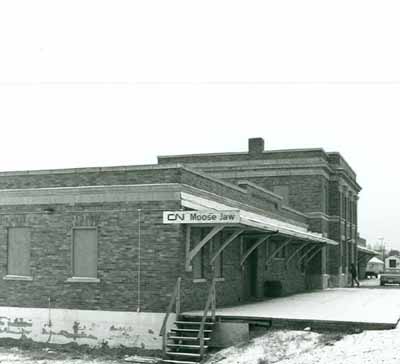Canadian National Railway Station
Heritage Railway Station of Canada
Moose Jaw, Saskatchewan

General view of the place
(© Analytica Associates, John L. Nicholls, 1991.)
Address :
341 Stadacona St. E., Moose Jaw, Saskatchewan
Recognition Statute:
Heritage Railway Stations Protection Act (R.S.C., 1985, c. 52 (4th Supp.))
Designation Date:
1992-06-04
Dates:
-
1919 to 1919
(Construction)
Event, Person, Organization:
-
Canadian National Railways
(Organization)
-
John Schofield
(Architect)
Research Report Number:
RS-119
Description of Historic Place
The Canadian National Railway (CNR) station at Moose Jaw is a monumental 2-storey structure built in 1919. It has an elegant Beaux Arts design and is located on a rise of land on Stadacona St. E. between Third and Fourth Avenues
Heritage Value
The station at Moose Jaw has been designated a heritage railway station because of its historical and architectural significance.
The Canadian National Railway (CNR) station at Moose Jaw was built in 1919 to the designs of architect John Schofield, working through the Office of the Architect, CNR Western Lines in Winnipeg. Schofield designed several important stations and hotels, and eventually became Chief Architect at Canadian National Railways in 1942. His Moose Jaw station is an austere, elegant structure with the formal symmetrical massing and restrained classical ornamentation typical of Beaux Arts buildings. It was built in the post-World War I era, just after several smaller lines joined to form the CNR and began to challenge the western monopoly of the Canadian Pacific Railway. The CNR regarded this Moose Jaw station as an early opportunity to establish its corporate identity on the southern Prairies.
The heritage value of the station is defined by its Beaux Arts-influenced design, by surviving elements of its interior finish and trim, and by its prominence on its site.
Source:
· Heritage Character Statement, Moose Jaw Canadian National Railways Station, March 1993. Heritage Assessment Report RSR-119, 1991.
Character-Defining Elements
Character-defining elements of the Moose Jaw Canadian National Railway Station include: its formal, symmetrical massing as a central two-storey block flanked by matching one-storey wings all under flat roof forms, its monumental proportions, the balanced, symmetrical placement of its apertures, its reference to classical architectural motifs as seen in the highly defined articulation of the east and west facades where four pilasters support a prominent entablature, its use of restrained classical ornamentation such as the simple curved brackets supporting its projecting canopies, the smooth incorporation of features necessary to railway operations such as the passenger canopies, the integrity and substantial quality of its exterior materials; red brick walls, cut stone details, steel canopies, their rich textures and finely crafted forms, the simple but elegant forms of details in the interior public area; trim elements, staircase features, wall paneling, and door and window details, their material integrity, high quality and rich textures, evidence of the station’s original bilaterally symmetrical floor plan, evidence of the spatial and functional definition of space within the building for railway use.